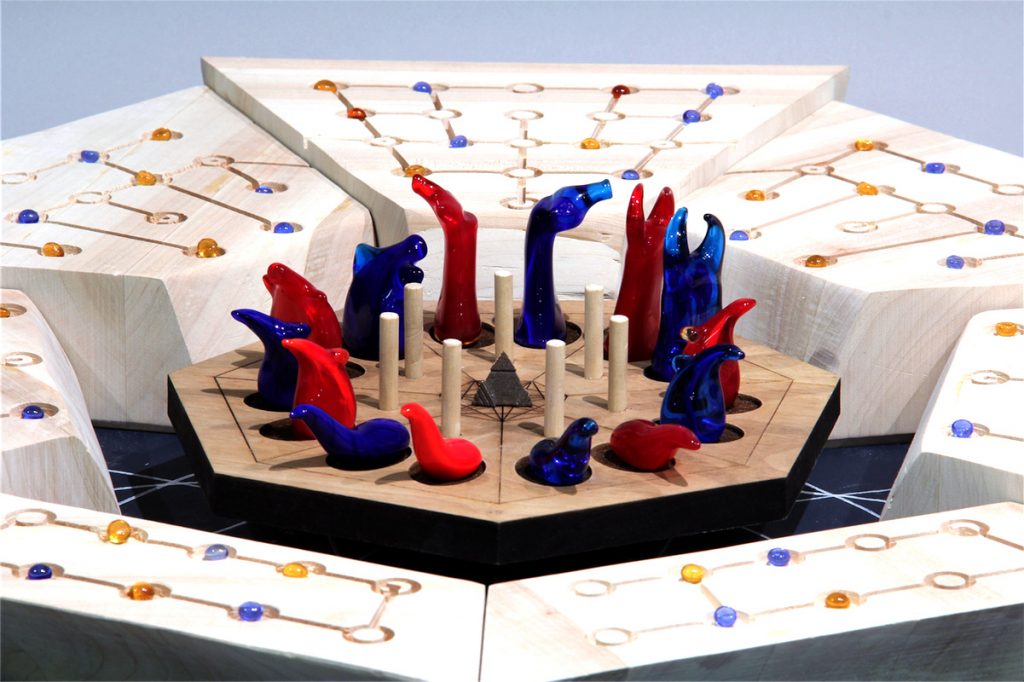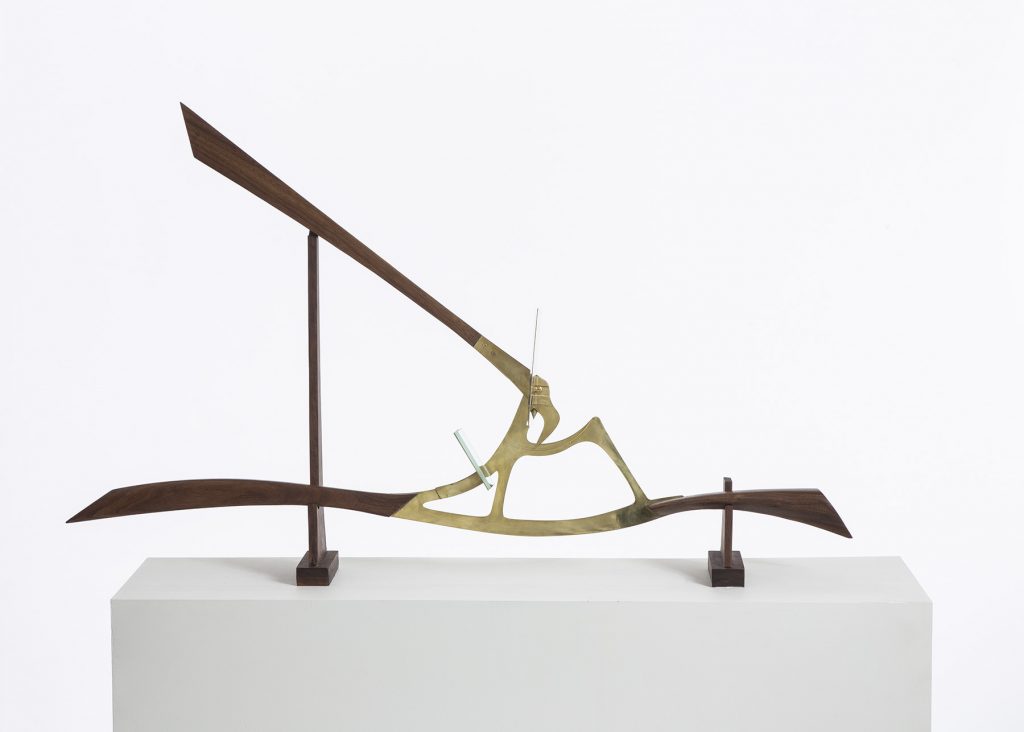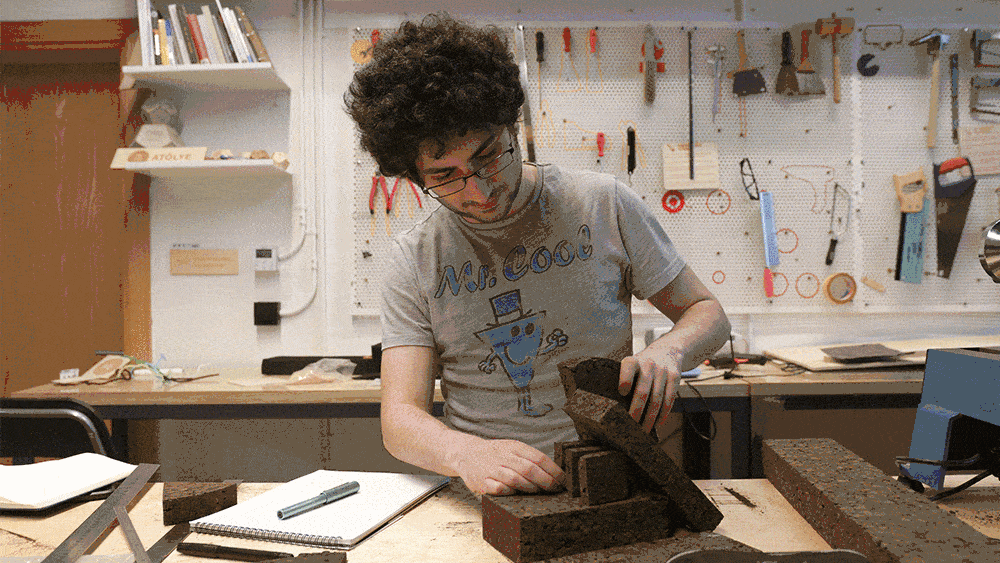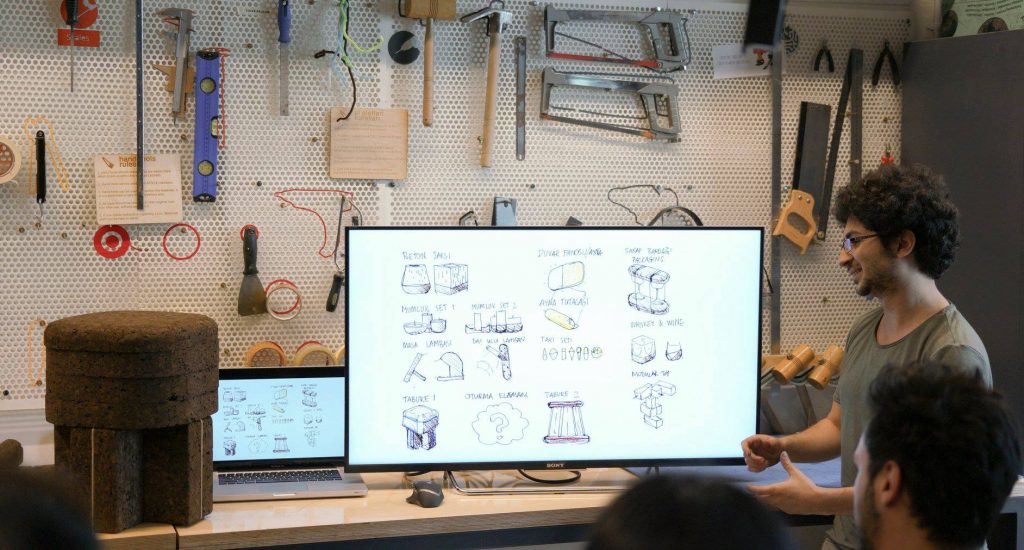The most recent iteration of the Designer-in-Residence program at ATÖLYE has seen their Prototyping Lab take on new life, where resident Eli Bensusan can regularly be found putting in the hours and making ample use of the resources afforded to him. Hailing from an international and multidisciplinary background, it’s clear Eli has taken on the role with a genuine understanding and enthusiasm for his work. Having spent the last few years in the United States completing his Master’s and building upon his skill sets in a number of roles, as well as founding Neferka – a jewelry brand emphasizing storytelling – Eli embodies an ethos of continual growth, always aiming to learn, experiment, and express. Echoing this, his recent return to Istanbul to pursue the program and work in a more hands-on capacity with cork has seen him push his portfolio in new and fascinating directions, intriguing those around him and bringing his distinct knack for sharing stories into the mix. With an upcoming open exhibition on Tuesday 3 July and a firm commitment to his recent undertakings, it’s safe to say this is just the start of a new chapter.
We took some time to speak with Eli on his strong foundation in the areas of storytelling and design, the meanings behind his vibrant portfolio of work with Neferka, the unique opportunities inherent to ATÖLYE’s Designer-in-Residence program, the projects therein, and what comes next for this talented designer.

Could you tell us a little bit about yourself?
I was born in 1989 in Istanbul. In kindergarten I used to love playing with blocks. A little bit older, I was designing lego-transformers. When I was in high school I was hanging out in the art room working on oil paintings, watercolors, photography and drawings. After high school Industrial Design felt like the right track to focus on. I took my bachelors degree in Industrial Design from Istanbul Technical University in 2013. Right after that I went to the School of the Art Institute of Chicago (SAIC) for my Master’s degree. I finished the program in 2015 and started working as a a lecturer there for a year in Designed Objects and Continuing Studies Departments. I was the lecturer for Design Storytelling, Toy Design and Digital Design classes. I also established my jewelry brand, Neferka there, meanwhile doing freelance design. After a while I started working at Studio KozSusani under Defne Koz and Marco Susani. At the end of my 5th year in Chicago, altough I really enjoyed listening to incredible live jazz and blues every and reading poetry at open mics I believed it was time to move on from there. Chicago is a great place, but I felt like there was more to discover. I found this great program at ATÖLYE and decided I could both work and think about what to do next.
Could you elaborate a bit on your professional background and how it eventually led to Neferka?
I had quite a traditional Industrial Design Education at ITU. During that time I had a couple internships. First at Adnan Serbest Mobilya, a furniture design firm with a strong sense of aesthetic, then Aslan Ruso, an award manufacturing workshop where I learnt the basics of traditional and digital tools. I think Demirden Design was the place that changed the way I perceived design. What struck me most was how subtle, smart and thoughtful they were about the story behind the object. The way they used form and material helped me to understand that I was also interested in this part of design – how it can be used to express a narrative.

My time at Istanbul Technical provided a strong technical background, but I wanted to improve myself on the conceptual background behind my projects. I wanted to see the world the way an artist sees the world, and then make objects. I don’t care about the differentiation between art and design. We all make things. I prefer to differentiate things with adjectives, such as utilitarian, poetic, thoughtful, philosophical. Unlike the common opinion, an artist might make utilitarian work, whereas a designer can be philosophical or poetic. Right after ITU, I started my Masters in the Designed Objects program at SAIC, a school actually well known for fine arts programs. Besides design, I took classes from performance and sculpture departments. It was there that I discovered I could integrate poetry, philosophy, and storytelling in design. After graduation I became a lecturer there. While this was happening I did some freelance work for Birsel+Seck. They create focus group innovation workshops for major companies in many different industries, helping them design their client’s future with their core values. This type of work helps a young designer gain a broader vision about how to transform a company ready for the future, the key points of current design trends and the future of design. Working on system design and UX/UI projects was great because technology is an inevitable part of our lives now. A while later I started working for Studio KozSusani, my experience there was unique. Defne Koz is one of the most well known designers from Turkey. She has a unique sensitivity about form. Marco Susani is an extremely skilled designer at project management and solving details, so this marriage of two identities create a very strong studio. I worked there on many furniture, tableware, and lighting projects. I remember one day Marco and Defne giving me feedback about the curves of a chair. They were saying this curve goes “woooo-wooo”, it should be “wooooouuuooooo”. They were talking about the continuity of the curve in a very sensitive, intuition based manner, which I believe is one of the most important keys to their practice – connect your eyes with your heart.
While all of these were happening I had already started Neferka, my jewelry company I based on my thesis work.
Could you expand a bit on that?
Sure. We didn’t have a written thesis, it was a studio project. In my thesis there were two objects, one was called “the object of space”, a sailor sextant (a tool used for celestial navigation using the stars) with giant handles, so in a way you use your body and this tool to find your location in a performative way. The other was called the “object of time”, a necklace and earring set that can be assembled to a functional sundial. We look at our phones and it tells us what time it is with numbers. We understand time and space in relation to numbers on a screen, but that’s not the only way to understand time – in fact I think it is terrible. The pieces I created were about utilizing the old technologies to create a different state of mind than when doing it on your phone. When you use them, space becomes about your relationship to the landscape, horizon, sky, and stars. Time becomes the movement of sunlight and shadow. Utilizing these objects create a psychological transformation. Object of time became a part of my jewelry brand, which means ‘the beautiful life force’ in ancient Egyptian. Every piece in the collection has a story. I also work with people who want to have unique pieces for themselves or others. I listen to their stories, I take key elements of that story and embed them to a piece of jewelry. There are projects on my website, but also some projects that my clients prefer not to be shared. Currently I am integrating poetry to the line as well, some pieces come with a poem. I started doing this after joining Uptown Poetry Ensemble in Chicago. I had been listening and performing poetry weekly for 2 years at a bar called the Green Mill. Every minute I spent there turns back to me as inspiration.

Are you still working on it here? How does it tie into the Designer-in-Residence program?
Yes. With cork, I’m planning a new set of jewelry with stories behind them. Everyone hopefully will see them at the exhibition on July 3rd here. I was inspired by a blog post on how cork is used to seal stories. For example, people trapped on an island put a note in a bottle, seal it with cork, and then its found hundreds of years later and their ancestors can read the note. I found it poetic. Cork is used to seal something and then it’s there forever. I am thinking to write very short poems or stories that go with the jewelry and use two other materials than cork as well. This is a small part of my residency project. Cork has its own story, and the most important thing for me is to understand the material qualities of cork and express them in objects.
What were your motivations to apply to the Designer-in-Residence program at ATÖLYE?
So I actually just came back to Turkey once I learned I was accepted into the program here. I was motivated by the idea of exploring cork. It’s less explored than other materials, such as wood. I also wanted to go back to making with hand. The last few years have been mostly doing 3D models on a computer. I want to explore by hand, do it by hand, finish by hand. Cork is a comparably easier material to process. Other than these reasons, ATÖLYE is a very nice environment and I wanted to be a part of it. There are great talks, presentations etc. There only a few designer-in-residence programs, not only in Istanbul, but all over the world. Artists have many, not us! I don’t really understand why. These kinds of programs are beneficial for both companies and designers. Designers don’t really get the chance to explore that much in their own studio. They’re doing their own thing. If you give them time, space, material and flexibility to do whatever they want though, then they’ll come up with unique results. It can only happen in certain environments and this is one of them. So I feel very lucky.

Could you tell us more about the Designer-in-Residence program in general?
ATOLYE provides a material for a chosen designer. The material I’m working with is cork, and the next one will be different. We have woodworking tools such as a table saw, a band saw, 3D printers, CNCs, a lathe, and basic hand tools. All of these are utilitarian when you’re working with materials that needs to be processed. There’s no other space that I know of in the city that has so many tools available to a designer 24/7. Some of these things are digital, and some of them are based on craftsmanship skills. With the combination of these two, it’s pretty much possible to do anything.
How hard is it to come across these types of resources otherwise?
3D printers are pretty accessible, but not for free. You need to pay for services and wait for long times. I never had woodworking tools, because it is impossible to do heavy woodworking in an office – especially a home-office. I like that you can get messy here. Also the location is close to Karakoy, which is a place where you can get pretty much anything get done if your tools are not enough or if you have difficulty.
Where are your sourcing your cork?
Amorim, a Portuguese cork company, is supporting us with all the cork as a sponsor. We have sheets, blocks, and rolls of fabric-paper-cork composites.
What will you be working on for the rest of the program and what are some of the projects you’ve focused on?
I have plenty of ideas, an entire sketchbook full, but I’m unsure of how many I’ll be able to realize. I worked on a stool, which might be good for kids. I’ve worked on a wall piece that combines a small shelf where you can put your perfumes and stuff, alongside a mirror and lighting. There are a couple of lamps. Bedside lamps, desk lamps… I have some experiments that I haven’t translated yet into products. I am working on things every day. I’m pretty much here all the time, trying to make the most out of my two months.
Sometimes I’m very productive, sometimes I’m standing and thinking I don’t like my ideas. Sometimes I spend a whole day trying to improve my ideas. In the end, it’s nice that there are always tools I can use and people I can ask. I had a Feedback Session with the other members of ATÖLYE that was really helpful. It’s great to have creative humans as a resource of idea exchange, especially when they’re qualified in many fields.
For now, I’m trying to create as much work as possible. Once I’m done, I will have all the designs properly 3D modeled and ready to go to manufacturing.

So there’s a bit less than a month left in the program, what’s the plan from here?
We’re going to have an exhibition on the 3rd of July. I would like to invite everyone who reads this. We are also going to have a conversation with the cork supplier and see if they’re interested in any of my projects. After the exhibition, I hope these projects find their own life and turn into products. Other than for them being my own designs, I will be supporting usage of cork for environmental reasons. You don’t have to cut a cork tree to get the cork. You strip the bark of a specific oak tree and when you do that, the tree actually creates more oxygen in the years that follow. 15 years later, you can strip the tree again. The tree is fine. It’s a good process and benefits the world. I am excited share my pieces with everyone.
To keep up with Eli and his work, be sure to visit his official site, as well as the official page for Neferka.
ATÖLYE Spotlight is our series on the inspiring community members of Istanbul’s most creative space.
All images courtesy of the interviewee.









